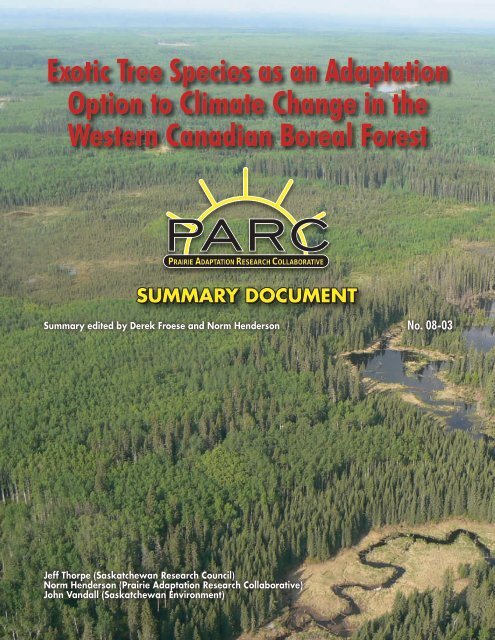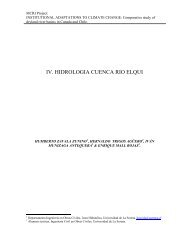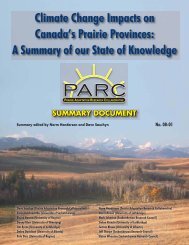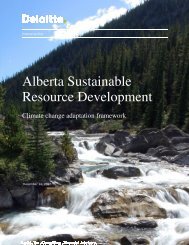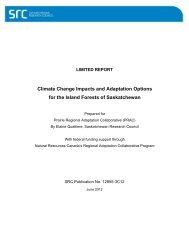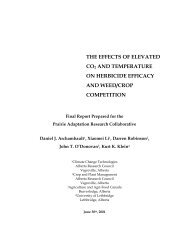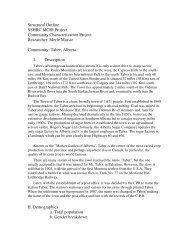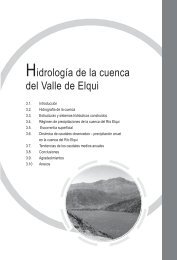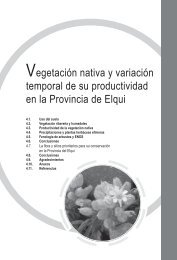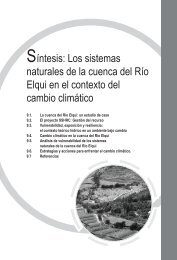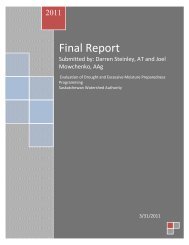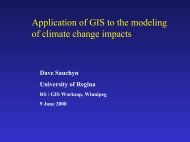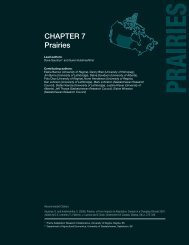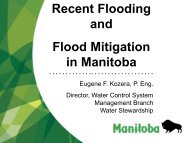Exotic Tree Species as an Adaptation Option to Climate Change in ...
Exotic Tree Species as an Adaptation Option to Climate Change in ...
Exotic Tree Species as an Adaptation Option to Climate Change in ...
Create successful ePaper yourself
Turn your PDF publications into a flip-book with our unique Google optimized e-Paper software.
<strong>Exotic</strong> <strong>Tree</strong> <strong>Species</strong> <strong>as</strong> <strong>an</strong> <strong>Adaptation</strong><br />
<strong>Option</strong> <strong>to</strong> <strong>Climate</strong> Ch<strong>an</strong>ge <strong>in</strong> the<br />
Western C<strong>an</strong>adi<strong>an</strong> Boreal Forest<br />
PARC<br />
PRAIRIE ADAPTATION RESEARCH COLLABORATIVE<br />
SUMMARY DOCUMENT<br />
Summary edited by Derek Froese <strong>an</strong>d Norm Henderson<br />
No. 08-03<br />
Jeff Thorpe (S<strong>as</strong>katchew<strong>an</strong> Research Council)<br />
Norm Henderson (Prairie <strong>Adaptation</strong> Research Collaborative)<br />
John V<strong>an</strong>dall (S<strong>as</strong>katchew<strong>an</strong> Environment)
Aspen-white spruce mixedwood<br />
This summary is b<strong>as</strong>ed on the follow<strong>in</strong>g larger document:<br />
Thorpe, J., N. Henderson, <strong>an</strong>d J. V<strong>an</strong>dall. 2006. Ecological <strong>an</strong>d Policy Implications of Introduc<strong>in</strong>g<br />
<strong>Exotic</strong> <strong>Tree</strong>s for <strong>Adaptation</strong> <strong>to</strong> <strong>Climate</strong> Ch<strong>an</strong>ge <strong>in</strong> the Western Boreal Forest. (S<strong>as</strong>katchew<strong>an</strong> Research<br />
Council Publication 11776-1E06). The full report is viewable at: http://www.adaptation.nrc<strong>an</strong>.gc.ca/pdf/<br />
29a4a56f96a347039fb43792635d8f44_e.pdf<br />
PARC acknowledges the support of Natural Resources C<strong>an</strong>ada, S<strong>as</strong>katchew<strong>an</strong> Environment <strong>an</strong>d the<br />
S<strong>as</strong>katchew<strong>an</strong> Research Council for the above project. Generous <strong>in</strong>-k<strong>in</strong>d contributions of time <strong>an</strong>d materials were<br />
made by SRC <strong>an</strong>d stakeholders from m<strong>an</strong>y org<strong>an</strong>izations. Brita Ma<strong>in</strong> of PARC contributed <strong>to</strong> the literature review,<br />
<strong>an</strong>d Charlene Hudym of SRC prepared the report for publication.<br />
This Summary is available for download from the PARC website (www.parc.ca).<br />
PARC acknowledges the fund<strong>in</strong>g support of S<strong>as</strong>katchew<strong>an</strong> Environment <strong>an</strong>d Alberta Environment.
Introduction<br />
Under conditions of climate ch<strong>an</strong>ge, ma<strong>in</strong>ta<strong>in</strong><strong>in</strong>g species <strong>an</strong>d<br />
ecosystem diversity <strong>in</strong> the western boreal forest may require<br />
<strong>in</strong>cre<strong>as</strong><strong>in</strong>gly <strong>in</strong>tensive m<strong>an</strong>agement policies. The purpose of<br />
this summary is <strong>to</strong> <strong>as</strong>sess the possibility of <strong>in</strong>troduc<strong>in</strong>g new<br />
tree species <strong>in</strong><strong>to</strong> the western boreal forest <strong>as</strong> <strong>an</strong> adaptation<br />
<strong>to</strong> climate ch<strong>an</strong>ge, <strong>an</strong>d discuss government policies <strong>to</strong><br />
address this issue. The regional focus is on the Boreal Pla<strong>in</strong><br />
Ecozone of M<strong>an</strong>i<strong>to</strong>ba, S<strong>as</strong>katchew<strong>an</strong>, <strong>an</strong>d Alberta. This<br />
region encomp<strong>as</strong>ses the ma<strong>in</strong> are<strong>as</strong> of production forestry <strong>in</strong><br />
these prov<strong>in</strong>ces, but also <strong>in</strong>cludes parks <strong>an</strong>d other protected<br />
are<strong>as</strong>, <strong>as</strong> well <strong>as</strong> are<strong>as</strong> along the southern fr<strong>in</strong>ge of the region<br />
where forest h<strong>as</strong> been cleared for agriculture.<br />
The study looks beyond the Prairie region <strong>to</strong> ga<strong>in</strong> a global<br />
perspective on the benefits of exotic tree species, the threats<br />
posed by these exotics, <strong>an</strong>d methods for <strong>as</strong>sess<strong>in</strong>g their<br />
<strong>in</strong>v<strong>as</strong>iveness. Next is <strong>an</strong> <strong>as</strong>sessment of present <strong>an</strong>d future<br />
climatic suitability for a number of native <strong>an</strong>d non-native<br />
tree species <strong>to</strong> the region under study. Seven non-native<br />
species are exam<strong>in</strong>ed <strong>in</strong> greater detail <strong>to</strong> determ<strong>in</strong>e their<br />
suitability for <strong>in</strong>troduction. F<strong>in</strong>ally, <strong>an</strong> exam<strong>in</strong>ation of<br />
global, federal, <strong>an</strong>d prov<strong>in</strong>cial policies on exotic tree species<br />
provides further context for the development of a new policy<br />
perspective on the issue <strong>an</strong>d policy recommendations.<br />
Rationale for Introduc<strong>in</strong>g <strong>Exotic</strong> <strong>Species</strong><br />
M<strong>an</strong>y re<strong>as</strong>ons exist for <strong>in</strong>troduc<strong>in</strong>g exotic tree species<br />
throughout the world. <strong>Exotic</strong> species provide a number<br />
of benefits <strong>to</strong> forestry <strong>in</strong> particular. In m<strong>an</strong>y c<strong>as</strong>es, exotic<br />
species grow f<strong>as</strong>ter th<strong>an</strong><br />
native species, have greater<br />
seed availability, are more<br />
e<strong>as</strong>ily m<strong>an</strong>aged, <strong>an</strong>d are better<br />
unders<strong>to</strong>od by foresters.<br />
Introduction of exotic trees<br />
c<strong>an</strong> also provide benefits <strong>to</strong><br />
the l<strong>an</strong>d <strong>an</strong>d ecosystems. Their<br />
<strong>in</strong>troduction h<strong>as</strong> frequently<br />
been justified by their value <strong>in</strong><br />
reclamation of disturbed are<strong>as</strong>,<br />
such <strong>as</strong> eroded l<strong>an</strong>ds (Zobel<br />
et al. 1987). F<strong>as</strong>t-grow<strong>in</strong>g<br />
exotic pl<strong>an</strong> tations also tend <strong>to</strong><br />
reduce the need for <strong>in</strong>tensive<br />
m<strong>an</strong>agement of the rema<strong>in</strong><strong>in</strong>g<br />
natural forest (Zobel et al.<br />
1987). It h<strong>as</strong> even been argued<br />
that exotic species c<strong>an</strong> have<br />
positive ecological value by<br />
contribut<strong>in</strong>g <strong>to</strong> the structure<br />
or function of a particular<br />
ecosystem (Williams 1997).<br />
A new rationale for <strong>in</strong>troduction<br />
of exotic trees is their<br />
possible role <strong>in</strong> adaptation <strong>to</strong><br />
climate ch<strong>an</strong>ge. Recent climate<br />
ch<strong>an</strong>ge <strong>as</strong>sessments <strong>in</strong> the Figure 1: Carag<strong>an</strong>a bushes<br />
3<br />
Prairie Prov<strong>in</strong>ces have made the po<strong>in</strong>t that the climate may<br />
become less suitable for native trees <strong>in</strong> some are<strong>as</strong>, lead<strong>in</strong>g<br />
<strong>to</strong> reduced growth, regeneration failure, <strong>an</strong>d gradual loss of<br />
forest cover. Retention of the economic <strong>an</strong>d environmental<br />
values <strong>as</strong>sociated with forest may require <strong>in</strong>troduction of<br />
exotic varieties or species that are adapted <strong>to</strong> the warmer <strong>an</strong>d<br />
drier climate (Thorpe et al. 2001, Henderson et al. 2002).<br />
Williams (1997) argued that exotic pl<strong>an</strong>ts now considered<br />
problematic may turn out <strong>to</strong> have ecological value <strong>in</strong> the<br />
future because of climate ch<strong>an</strong>ge, by fill<strong>in</strong>g the ecological<br />
roles played by native species that have been elim<strong>in</strong>ated.<br />
Threats from Introduc<strong>in</strong>g <strong>Exotic</strong> <strong>Tree</strong> <strong>Species</strong><br />
<strong>Exotic</strong> species c<strong>an</strong> pose a number of threats <strong>to</strong> regions <strong>an</strong>d<br />
ecosystems. Threats of dise<strong>as</strong>e tr<strong>an</strong>smission, genetic crosshybridization,<br />
site degradation, <strong>an</strong>d biodiversity loss have<br />
been documented <strong>in</strong> various regions of the world. Globally<br />
the most import<strong>an</strong>t threat attached <strong>to</strong> the <strong>in</strong>troduction<br />
of exotic pl<strong>an</strong>ts is the potential for <strong>in</strong>v<strong>as</strong>ion of adjacent<br />
ecosystems. While most successful <strong>in</strong>v<strong>as</strong>ions do not alter<br />
large-scale ecosystem processes, some <strong>in</strong>v<strong>as</strong>ions do have<br />
major impacts (Vi<strong>to</strong>usek 1990). This happens <strong>in</strong> situations<br />
<strong>in</strong> which <strong>in</strong>vaders:<br />
• Differ subst<strong>an</strong>tially from natives <strong>in</strong> resource<br />
acquisition or utilization<br />
• Alter the trophic structure of the <strong>in</strong>vaded area<br />
• Alter disturb<strong>an</strong>ce frequency <strong>an</strong>d/or <strong>in</strong>tensity<br />
Depend<strong>in</strong>g on the situation, certa<strong>in</strong> exotics are deemed<br />
<strong>to</strong> be more <strong>in</strong>v<strong>as</strong>ive th<strong>an</strong> others. In C<strong>an</strong>ada, the follow<strong>in</strong>g
exotic shrubs <strong>an</strong>d trees have been considered <strong>in</strong>v<strong>as</strong>ive <strong>in</strong><br />
parks <strong>an</strong>d other protected are<strong>as</strong>: Europe<strong>an</strong> birch, Scots p<strong>in</strong>e,<br />
common buckthorn, glossy buckthorn, white mulberry,<br />
<strong>an</strong>d Scotch broom (Mosqu<strong>in</strong> 1997). <strong>Tree</strong>s <strong>an</strong>d shrubs are<br />
less conspicuous <strong>as</strong> <strong>in</strong>v<strong>as</strong>ive species <strong>in</strong> the Prairie region,<br />
but three species <strong>in</strong>tentionally <strong>in</strong>troduced for horticultural<br />
purposes, Siberi<strong>an</strong> elm, carag<strong>an</strong>a, <strong>an</strong>d common buckthorn<br />
(Archibold et al. 1997), are extremely <strong>in</strong>v<strong>as</strong>ive <strong>in</strong> local are<strong>as</strong>.<br />
Carag<strong>an</strong>a is one of the most widely distributed species for<br />
shelterbelt pl<strong>an</strong>t<strong>in</strong>gs. In the <strong>as</strong>pen parkl<strong>an</strong>d <strong>an</strong>d forest fr<strong>in</strong>ge,<br />
where agricultural settlement is <strong>in</strong> contact with boreal forest,<br />
there are m<strong>an</strong>y are<strong>as</strong> where carag<strong>an</strong>a h<strong>as</strong> aggressively<br />
spread <strong>in</strong><strong>to</strong> <strong>as</strong>pen st<strong>an</strong>ds, virtually elim<strong>in</strong>at<strong>in</strong>g the native<br />
unders<strong>to</strong>ry pl<strong>an</strong>ts. The observed <strong>in</strong>v<strong>as</strong>ive behaviour of some<br />
<strong>in</strong>tentionally <strong>in</strong>troduced species, even if they are only a<br />
small fraction of the <strong>to</strong>tal number of <strong>in</strong>troductions, provides<br />
the ma<strong>in</strong> re<strong>as</strong>on for concern about future <strong>in</strong>troductions.<br />
Assess<strong>in</strong>g the Inv<strong>as</strong>ion Problem<br />
Inv<strong>as</strong>ion of <strong>an</strong> exotic species depends on the biological<br />
characteristics of the species, the characteristics of the<br />
receiv<strong>in</strong>g habitat, <strong>an</strong>d the <strong>in</strong>teractions between species <strong>an</strong>d<br />
habitat. Because the <strong>in</strong>v<strong>as</strong>ion process consists of a series of<br />
steps, each of which may have different barriers that must<br />
be overcome, the <strong>in</strong>v<strong>as</strong>iveness of a species is difficult <strong>to</strong><br />
predict (Heger <strong>an</strong>d Trepl 2003). In spite of these limitations,<br />
a number of st<strong>an</strong>dardized systems have been developed<br />
for screen<strong>in</strong>g proposed <strong>in</strong>troductions for potential <strong>in</strong>v<strong>as</strong>ive<br />
behaviour. These systems are of vary<strong>in</strong>g complexity, but<br />
typically <strong>as</strong>k a number of questions <strong>to</strong> determ<strong>in</strong>e whether<br />
the species should be accepted, rejected, or further tested<br />
<strong>an</strong>d moni<strong>to</strong>red. Reichard <strong>an</strong>d Hamil<strong>to</strong>n (1997) developed a<br />
system b<strong>as</strong>ed on <strong>an</strong> <strong>an</strong>alysis of woody species <strong>in</strong>tentionally<br />
<strong>in</strong>troduced <strong>in</strong><strong>to</strong> North America. It w<strong>as</strong> found that conifers<br />
tend <strong>to</strong> be non-<strong>in</strong>v<strong>as</strong>ive <strong>in</strong> North America, <strong>an</strong>d that species<br />
native <strong>to</strong> North America do not tend <strong>to</strong> be <strong>in</strong>v<strong>as</strong>ive when<br />
<strong>in</strong>troduced <strong>to</strong> new North Americ<strong>an</strong> habitats.<br />
<strong>Climate</strong> Ch<strong>an</strong>ge Impacts<br />
A new <strong>as</strong>pect of the <strong>in</strong>v<strong>as</strong>ibility question is the potential<br />
impact of climate ch<strong>an</strong>ge. As with <strong>an</strong>y species, exotic pl<strong>an</strong>ts<br />
are adapted <strong>to</strong> a given r<strong>an</strong>ge of climates, <strong>an</strong>d climate ch<strong>an</strong>ge<br />
could either exp<strong>an</strong>d or shr<strong>in</strong>k the r<strong>an</strong>ge that is suitable for<br />
a given exotic species. <strong>Climate</strong> ch<strong>an</strong>ge may discrim<strong>in</strong>ate<br />
aga<strong>in</strong>st species that c<strong>an</strong>not quickly extend their r<strong>an</strong>ges <strong>in</strong><strong>to</strong><br />
new regions. The result may be poorly adapted communities<br />
that are susceptible <strong>to</strong> <strong>in</strong>v<strong>as</strong>ion, especially by f<strong>as</strong>t-dispers<strong>in</strong>g<br />
species that c<strong>an</strong> shift r<strong>an</strong>ges rapidly. <strong>Species</strong> that <strong>to</strong>lerate a<br />
wide r<strong>an</strong>ge of climates <strong>in</strong> their native r<strong>an</strong>ge are most likely<br />
<strong>to</strong> be successful <strong>in</strong>vaders, <strong>an</strong>d their climatic <strong>to</strong>ler<strong>an</strong>ce could<br />
give them <strong>an</strong> adv<strong>an</strong>tage <strong>as</strong> native species are stressed by<br />
climate ch<strong>an</strong>ge (Dukes <strong>an</strong>d Mooney 1999).<br />
<strong>Climate</strong> Suitability for Introduced <strong>Tree</strong> <strong>Species</strong> <strong>in</strong><br />
the Western Boreal Forest: Methodology<br />
The study area w<strong>as</strong> def<strong>in</strong>ed <strong>as</strong> <strong>in</strong>clud<strong>in</strong>g the Prairie, Boreal<br />
Pla<strong>in</strong>, <strong>an</strong>d Boreal Shield Ecozones between 49º <strong>an</strong>d 57º<br />
4<br />
north latitude, <strong>an</strong>d 96º <strong>an</strong>d 120º west longitude. Three<br />
bioclimatic variables were exam<strong>in</strong>ed <strong>to</strong> determ<strong>in</strong>e present<br />
<strong>an</strong>d future climatic suitability of native <strong>an</strong>d non-native tree<br />
species <strong>in</strong> this region: grow<strong>in</strong>g-degree days, w<strong>in</strong>ter m<strong>in</strong>imum<br />
temperatures, <strong>an</strong>d a moisture <strong>in</strong>dex. Thompson et al. (2000a,<br />
2000b) developed statistical distributions for these variables<br />
over North Americ<strong>an</strong> tree <strong>an</strong>d shrub species. For this study,<br />
the 10th <strong>an</strong>d 90th percentiles from these distributions were<br />
used <strong>to</strong> represent the climatic envelope of each species. A<br />
similar methodology for <strong>as</strong>sess<strong>in</strong>g the climatic envelope of<br />
Siberi<strong>an</strong> vegetation types from Tchebakova et al. (1994)<br />
w<strong>as</strong> adopted for Scots p<strong>in</strong>e <strong>an</strong>d Siberi<strong>an</strong> larch.<br />
A number of coniferous <strong>an</strong>d broad-leaved species occurr<strong>in</strong>g<br />
with<strong>in</strong> the study area <strong>an</strong>d <strong>in</strong> adjacent regions were considered,<br />
<strong>in</strong> addition <strong>to</strong> the two Eur<strong>as</strong>i<strong>an</strong> species. These <strong>in</strong>cluded<br />
native boreal species (white spruce, black spruce, balsam<br />
fir, jack p<strong>in</strong>e, tamarack, trembl<strong>in</strong>g <strong>as</strong>pen, balsam poplar,<br />
<strong>an</strong>d white birch); hardwood trees of the southern Prairie<br />
prov<strong>in</strong>ces (M<strong>an</strong>i<strong>to</strong>ba maple, green <strong>as</strong>h, Americ<strong>an</strong> elm, <strong>an</strong>d<br />
bur oak); species <strong>as</strong>sociated with the Great Lakes region <strong>an</strong>d<br />
further e<strong>as</strong>t (sugar maple, northern red oak, <strong>an</strong>d b<strong>as</strong>swood);<br />
<strong>an</strong>d western mont<strong>an</strong>e conifers (Dougl<strong>as</strong>-fir, ponderosa p<strong>in</strong>e,<br />
Rocky Mounta<strong>in</strong> juniper, <strong>an</strong>d lodgepole p<strong>in</strong>e).<br />
The current climate w<strong>as</strong> represented by 1961-90 normals for<br />
monthly temperature <strong>an</strong>d precipitation, while future climates<br />
were represented by three scenarios of Global <strong>Climate</strong><br />
Models (GCMs) for the 2041-2070 period (referred <strong>to</strong> <strong>as</strong> the<br />
2050s). The approach w<strong>as</strong> <strong>to</strong> compare the present <strong>an</strong>d future<br />
climates <strong>in</strong> the C<strong>an</strong>adi<strong>an</strong> Prairies with the climatic envelopes<br />
of these species <strong>to</strong> judge their climatic suitability. If all three<br />
bioclimatic variables fell with<strong>in</strong> the 10%/90% r<strong>an</strong>ge, the<br />
area w<strong>as</strong> considered <strong>to</strong> be suitable. Results were mapped by<br />
compar<strong>in</strong>g the present map with one of the future maps <strong>an</strong>d<br />
determ<strong>in</strong><strong>in</strong>g the follow<strong>in</strong>g categories for each species:<br />
• Cont<strong>in</strong>ued unsuitability – unsuitable <strong>in</strong> both 1961-<br />
90 <strong>an</strong>d 2041-70<br />
• Decl<strong>in</strong><strong>in</strong>g suitability – suitable <strong>in</strong> 1961-90,<br />
unsuitable <strong>in</strong> 2041-70<br />
• Cont<strong>in</strong>ued suitability – suitable <strong>in</strong> both 1961-90 <strong>an</strong>d<br />
2041-70<br />
• Incre<strong>as</strong><strong>in</strong>g suitability – unsuitable <strong>in</strong> 1961-90,<br />
suitable <strong>in</strong> 2041-70<br />
Climatic Suitability of Native <strong>an</strong>d Non-Native<br />
<strong>Species</strong><br />
The bioclimatic variables were mapped for the current<br />
climate <strong>an</strong>d one of the GCM scenarios (Figures 2 <strong>to</strong> 4). The<br />
grow<strong>in</strong>g degree-days variable shows a subst<strong>an</strong>tial ch<strong>an</strong>ge,<br />
with all parts of the study area predicted <strong>to</strong> have much<br />
warmer grow<strong>in</strong>g se<strong>as</strong>ons. Me<strong>an</strong> temperature of the coldest<br />
month shows more moderate shifts <strong>to</strong>wards milder w<strong>in</strong>ters<br />
<strong>in</strong> all regions. The moisture <strong>in</strong>dex shows slight shifts <strong>to</strong>wards<br />
somewhat drier conditions <strong>in</strong> most regions.<br />
Application of the bioclimatic model <strong>to</strong> the current <strong>an</strong>d<br />
future climate for native <strong>an</strong>d non-native tree species (Figures<br />
5 <strong>to</strong> 8) resulted <strong>in</strong> the follow<strong>in</strong>g conclusions:
Cities <strong>as</strong> shown<br />
on maps:<br />
E – Edmon<strong>to</strong>n<br />
C – Calgary<br />
S – S<strong>as</strong>ka<strong>to</strong>on<br />
R – Reg<strong>in</strong>a<br />
W – W<strong>in</strong>nipeg<br />
Figure 2: Grow<strong>in</strong>g degree-days (5°C b<strong>as</strong>e) for the study area, <strong>in</strong> the current climate (<strong>to</strong>p) <strong>an</strong>d <strong>in</strong> the CSIROMk2b<br />
B11 scenario for the 2050s (bot<strong>to</strong>m).<br />
5
Cities <strong>as</strong> shown<br />
on maps:<br />
E – Edmon<strong>to</strong>n<br />
C – Calgary<br />
S – S<strong>as</strong>ka<strong>to</strong>on<br />
R – Reg<strong>in</strong>a<br />
W – W<strong>in</strong>nipeg<br />
Figure 3: Me<strong>an</strong> temperature of the coldest month (°C) for the study area, <strong>in</strong> the current climate (<strong>to</strong>p) <strong>an</strong>d <strong>in</strong> the<br />
CSIROMk2b B11 scenario for the 2050s.<br />
6
Figure 4: Moisture <strong>in</strong>dex (actual evapotr<strong>an</strong>spiration divided by potential evapotr<strong>an</strong>spiration) for the study area, <strong>in</strong><br />
the current climate (<strong>to</strong>p) <strong>an</strong>d <strong>in</strong> the CSIROMk2b B11 scenario for the 2050s (bot<strong>to</strong>m)<br />
7
Cities <strong>as</strong> shown<br />
on maps:<br />
E – Edmon<strong>to</strong>n<br />
C – Calgary<br />
S – S<strong>as</strong>ka<strong>to</strong>on<br />
R – Reg<strong>in</strong>a<br />
W – W<strong>in</strong>nipeg<br />
Figure 5: Ch<strong>an</strong>ges <strong>in</strong> climatic suitability for trembl<strong>in</strong>g <strong>as</strong>pen from the current climate (1961-90<br />
normals) <strong>to</strong> the CSIROMk2b B11 scenario for the 2050s.<br />
Figure 6: Ch<strong>an</strong>ges <strong>in</strong> climatic suitability for M<strong>an</strong>i<strong>to</strong>ba maple from the current climate (1961-90<br />
normals) <strong>to</strong> the CSIROMk2b B11 scenario for the 2050s.<br />
8
Figure 7: Ch<strong>an</strong>ges <strong>in</strong> climatic suitability for Dougl<strong>as</strong>-fir from the current climate (1961-90 normals) <strong>to</strong><br />
the CSIROMk2b B11 scenario for the 2050s.<br />
Figure 8: Ch<strong>an</strong>ges <strong>in</strong> climatic suitability for Siberi<strong>an</strong> larch from the current climate (1961-90 normals)<br />
<strong>to</strong> the CSIROMk2b B11 scenario for the 2050s.<br />
9
• Native boreal species<br />
are expected <strong>to</strong> shift<br />
northward <strong>in</strong> distribution,<br />
probably decl<strong>in</strong><strong>in</strong>g <strong>in</strong><br />
viability <strong>in</strong> the southern<br />
parts of their current<br />
r<strong>an</strong>ge.<br />
• Hardwoods of the<br />
southern Prairies may be<br />
suitable for a larger <strong>an</strong>d<br />
more northerly r<strong>an</strong>ge <strong>in</strong><br />
the future.<br />
• <strong>Species</strong> of the Great<br />
Lakes region may be<br />
limited <strong>in</strong> suitability for<br />
our region by climatic<br />
dryness, which is<br />
expected <strong>to</strong> <strong>in</strong>cre<strong>as</strong>e.<br />
• Western conifers such<br />
<strong>as</strong> Dougl<strong>as</strong>-fir <strong>an</strong>d<br />
ponderosa p<strong>in</strong>e may be<br />
more suitable for the<br />
milder western parts of<br />
the study area, provided<br />
that moisture is adequate.<br />
The area currently<br />
suitable for lodgepole<br />
p<strong>in</strong>e <strong>in</strong> northwestern<br />
Alberta is predicted <strong>to</strong><br />
decre<strong>as</strong>e almost <strong>to</strong> the<br />
po<strong>in</strong>t of elim<strong>in</strong>ation,<br />
driven by the rise <strong>in</strong><br />
grow<strong>in</strong>g degree-days<br />
beyond its modeled<br />
threshold.<br />
• Eur<strong>as</strong>i<strong>an</strong> boreal species<br />
such <strong>as</strong> Scots p<strong>in</strong>e <strong>an</strong>d<br />
Siberi<strong>an</strong> larch may be<br />
more <strong>to</strong>ler<strong>an</strong>t of climatic<br />
dryness th<strong>an</strong> the native<br />
boreal species, but may<br />
not be suited <strong>to</strong> the<br />
<strong>in</strong>cre<strong>as</strong>ed warmth <strong>in</strong><br />
southern regions.<br />
Figure 9: Red p<strong>in</strong>e<br />
C<strong>as</strong>e Studies of Selected <strong>Species</strong><br />
To look more closely at the issues related <strong>to</strong> tree <strong>in</strong>troductions,<br />
<strong>in</strong>formation w<strong>as</strong> gathered on several species that<br />
might be considered for pl<strong>an</strong>t<strong>in</strong>g for forestry purposes <strong>in</strong><br />
our region. These <strong>in</strong>cluded three western North Americ<strong>an</strong><br />
conifers (lodge pole p<strong>in</strong>e, ponderosa p<strong>in</strong>e, <strong>an</strong>d Dougl<strong>as</strong>-fir),<br />
one e<strong>as</strong>tern North Americ<strong>an</strong> conifer (red p<strong>in</strong>e), two Eur<strong>as</strong>i<strong>an</strong><br />
conifers (Scots p<strong>in</strong>e <strong>an</strong>d Siberi<strong>an</strong> larch), <strong>an</strong>d hybrid poplar,<br />
which is currently be<strong>in</strong>g widely pl<strong>an</strong>ted <strong>in</strong> the region.<br />
Information gathered on the species <strong>in</strong>cluded future climatic<br />
suitability (<strong>as</strong> already discussed) <strong>an</strong>d fac<strong>to</strong>rs such <strong>as</strong> native<br />
habitat <strong>an</strong>d biological characteristics <strong>to</strong> <strong>as</strong>sess <strong>in</strong>v<strong>as</strong>iveness.<br />
Most of the species were <strong>as</strong>sessed for potential <strong>in</strong>v<strong>as</strong>iveness<br />
us<strong>in</strong>g the Americ<strong>an</strong> model developed by Reichard <strong>an</strong>d<br />
Hamil<strong>to</strong>n (1997).<br />
Analysis of these species produced the follow<strong>in</strong>g conclusions:<br />
• Relative <strong>in</strong>v<strong>as</strong>iveness b<strong>as</strong>ed on biological<br />
characteristics <strong>an</strong>d behaviour elsewhere, r<strong>an</strong>ks the<br />
species <strong>as</strong> follows (from greatest <strong>to</strong> le<strong>as</strong>t <strong>in</strong>v<strong>as</strong>ive):<br />
lodgepole p<strong>in</strong>e, Scots p<strong>in</strong>e, Dougl<strong>as</strong>-fir, ponderosa<br />
p<strong>in</strong>e, red p<strong>in</strong>e. There is <strong>in</strong>sufficient <strong>in</strong>formation <strong>to</strong><br />
place Siberi<strong>an</strong> larch <strong>in</strong> this list.<br />
• Application of the Reichard <strong>an</strong>d Hamil<strong>to</strong>n (1997)<br />
decision tree for predict<strong>in</strong>g <strong>in</strong>v<strong>as</strong>ions <strong>in</strong> North<br />
America suggested that further <strong>an</strong>alysis/moni<strong>to</strong>r<strong>in</strong>g<br />
is required for lodgepole p<strong>in</strong>e, ponderosa p<strong>in</strong>e, <strong>an</strong>d<br />
10
Dougl<strong>as</strong>-fir; that red p<strong>in</strong>e should be accepted; <strong>an</strong>d<br />
that Scots p<strong>in</strong>e should be rejected.<br />
• Most of the species are unlikely <strong>to</strong> <strong>in</strong>vade <strong>in</strong>tact<br />
forests <strong>as</strong> they are predom<strong>in</strong><strong>an</strong>tly shade-<strong>in</strong><strong>to</strong>ler<strong>an</strong>t,<br />
early-seral species. However, all species could<br />
<strong>in</strong>vade open habitats adjacent <strong>to</strong> pl<strong>an</strong>tations <strong>an</strong>d<br />
could regenerate follow<strong>in</strong>g disturb<strong>an</strong>ce <strong>in</strong> adjacent<br />
forests.<br />
• Inv<strong>as</strong>ion is likely <strong>to</strong> be a slow process for these<br />
species, <strong>as</strong> most seedfall occurs <strong>in</strong> close proximity<br />
<strong>to</strong> parent trees, <strong>an</strong>d long-dist<strong>an</strong>ce spread is possible<br />
but less likely.<br />
• Gene tr<strong>an</strong>sfer could pose risk <strong>in</strong> the c<strong>as</strong>e of hybrid<br />
poplars which could cross with native cot<strong>to</strong>nwoods,<br />
but it is not clear whether the risk is signific<strong>an</strong>t.<br />
Figure 10: Lodgepole p<strong>in</strong>e<br />
11<br />
Policy on Introduction of <strong>Exotic</strong> <strong>Tree</strong> <strong>Species</strong><br />
The International Union for Conservation of Nature <strong>an</strong>d<br />
Natural Resources (IUCN 1987) recommends that exotic<br />
species should never be <strong>in</strong>troduced <strong>in</strong><strong>to</strong> <strong>an</strong>y natural habitat,<br />
<strong>an</strong>d only when there are exceptional re<strong>as</strong>ons for do<strong>in</strong>g<br />
so should <strong>an</strong> exotic species be <strong>in</strong>troduced <strong>in</strong><strong>to</strong> a sem<strong>in</strong>atural<br />
habitat. Even if these criteria are met, <strong>an</strong> extensive<br />
<strong>as</strong>sessment of benefits <strong>an</strong>d risks <strong>an</strong>d moni<strong>to</strong>red field trials<br />
are called for before the species c<strong>an</strong> be <strong>in</strong>troduced more<br />
extensively. Furthermore, the org<strong>an</strong>ization <strong>in</strong>troduc<strong>in</strong>g the<br />
species should bear the cost of control.<br />
<strong>Exotic</strong> species policy <strong>in</strong> the United States <strong>an</strong>d Europe<strong>an</strong><br />
Union varies from jurisdiction <strong>to</strong> jurisdiction, but is<br />
generally much less str<strong>in</strong>gent th<strong>an</strong> IUCN policy. The most<br />
relev<strong>an</strong>t federal legislation <strong>in</strong><br />
the United States is the Noxious<br />
Weed Act 1974, which prohibits<br />
the import of 94 listed pl<strong>an</strong>ts,<br />
but does not prohibit the entry of<br />
exotics. While Europe<strong>an</strong> Union<br />
legislation conta<strong>in</strong>s provisions <strong>to</strong><br />
ensure that exotic <strong>in</strong>troductions<br />
do not prejudice local flora <strong>an</strong>d<br />
fauna, Europe<strong>an</strong> nations have<br />
a long his<strong>to</strong>ry of import<strong>in</strong>g<br />
<strong>an</strong>d domesticat<strong>in</strong>g m<strong>an</strong>y new<br />
pl<strong>an</strong>t species, <strong>in</strong>clud<strong>in</strong>g exotic<br />
conifers.<br />
In C<strong>an</strong>ada there is no known<br />
example of <strong>an</strong> exotic tree<br />
whose tr<strong>an</strong>sport <strong>an</strong>d pl<strong>an</strong>t<strong>in</strong>g is<br />
forbidden by law. The federal<br />
Pl<strong>an</strong>t Protection Act 1995<br />
proscribes the import <strong>to</strong> C<strong>an</strong>ada<br />
or tr<strong>an</strong>sport with<strong>in</strong> C<strong>an</strong>ada<br />
of various species, but <strong>in</strong> the<br />
<strong>in</strong>terests of phy<strong>to</strong>s<strong>an</strong>itation, not<br />
<strong>in</strong>v<strong>as</strong>iveness. The “New Subst<strong>an</strong>ces<br />
Notifications Regulations:<br />
under the C<strong>an</strong>adi<strong>an</strong><br />
Environmental Protection Act<br />
1999 could also require <strong>an</strong><br />
extensive risk <strong>as</strong>sessment of a<br />
new non-C<strong>an</strong>adi<strong>an</strong> tree species<br />
imported <strong>in</strong><strong>to</strong> C<strong>an</strong>ada, but the<br />
regulations seem largely directed<br />
at <strong>in</strong>org<strong>an</strong>ics, micro-org<strong>an</strong>isms<br />
<strong>an</strong>d potential impacts on hum<strong>an</strong><br />
health, though <strong>in</strong>v<strong>as</strong>iveness is<br />
also a concern.<br />
All three Prairie Prov<strong>in</strong>ces have<br />
similar Acts <strong>to</strong> control the spread<br />
of undesired species, particularly<br />
weeds, but none are directed<br />
at trees. In the western boreal,<br />
there are no legal prohibitions<br />
aga<strong>in</strong>st the <strong>in</strong>troduction of exotic
tree species. <strong>Exotic</strong>s c<strong>an</strong> be <strong>an</strong>d are frequently pl<strong>an</strong>ted on<br />
freehold l<strong>an</strong>d. In general, s<strong>to</strong>ck<strong>in</strong>g policies on Crown l<strong>an</strong>d <strong>in</strong><br />
these prov<strong>in</strong>ces precludes the <strong>in</strong>troduction of exotic species,<br />
although some test pl<strong>an</strong>tations of exotics are underway.<br />
A Different Perspective: <strong>Exotic</strong> <strong>Species</strong> <strong>an</strong>d<br />
<strong>Adaptation</strong> <strong>to</strong> <strong>Climate</strong> Ch<strong>an</strong>ge<br />
In m<strong>an</strong>y well-documented c<strong>as</strong>es around the world, <strong>in</strong>troduced<br />
exotic pl<strong>an</strong>ts have been identified <strong>as</strong> serious threats <strong>to</strong><br />
biodiversity <strong>an</strong>d other values, usually because of <strong>in</strong>v<strong>as</strong>ive<br />
behaviour lead<strong>in</strong>g <strong>to</strong> alteration of neighbour<strong>in</strong>g ecosystems.<br />
Recent developments <strong>in</strong> policy have focused on reduc<strong>in</strong>g<br />
these threats <strong>in</strong> order <strong>to</strong> protect exist<strong>in</strong>g ecosystems. In<br />
addition, conservation strategies throughout North America<br />
have focused on protect<strong>in</strong>g representative are<strong>as</strong> from hum<strong>an</strong><br />
impact without <strong>in</strong>corporat<strong>in</strong>g the impacts of climate ch<strong>an</strong>ge.<br />
The <strong>in</strong>cre<strong>as</strong><strong>in</strong>g evidence for global climate ch<strong>an</strong>ge suggests<br />
that a different perspective may be needed on the issue of<br />
exotic species <strong>an</strong>d conservation m<strong>an</strong>agement.<br />
Under conditions of climate ch<strong>an</strong>ge, if we wish <strong>to</strong> ma<strong>in</strong>ta<strong>in</strong><br />
species <strong>an</strong>d ecosystem diversity, we may have <strong>to</strong> ab<strong>an</strong>don<br />
a laissez-faire wilderness preservation model <strong>an</strong>d adopt<br />
<strong>in</strong>cre<strong>as</strong><strong>in</strong>gly <strong>in</strong>tensive m<strong>an</strong>agement policies. These could<br />
<strong>in</strong>clude deliberately <strong>as</strong>sist<strong>in</strong>g the movement of species <strong>to</strong><br />
newly suitable habitats. This issue is particularly acute for<br />
forest systems, where natural migration (for example, of<br />
new tree species or of climatically more suitable genetic<br />
varieties of locally ext<strong>an</strong>t tree species) may not be possible<br />
without hum<strong>an</strong> <strong>in</strong>tervention.<br />
With the correct policies <strong>in</strong> place, exotic tree species could<br />
play a signific<strong>an</strong>t role <strong>in</strong> adaptation. As the r<strong>an</strong>ge <strong>an</strong>d density<br />
of exist<strong>in</strong>g species ch<strong>an</strong>ges with climate, new species could<br />
be sought <strong>to</strong> replicate <strong>as</strong> closely <strong>as</strong> possible the ecological<br />
function of native species. M<strong>an</strong>agement of the area should<br />
focus not only on the potential <strong>in</strong>v<strong>as</strong>iveness of the exotic<br />
species, but on whether the species contributes <strong>to</strong> largescale<br />
biodiversity preservation with<strong>in</strong> the ecosystem. The<br />
<strong>in</strong>troduction of new species might contribute <strong>to</strong> the resilience<br />
of the western boreal <strong>in</strong> the face of oncom<strong>in</strong>g ch<strong>an</strong>ges.<br />
Figure 11: <strong>Exotic</strong> tree pl<strong>an</strong>tation <strong>in</strong> southern Alberta<br />
12
Policy Recommendations<br />
A number of policy recommendations have been developed<br />
<strong>as</strong> a result of the scientific literature review, the policy review,<br />
<strong>an</strong>d <strong>in</strong>put from a stakeholders workshop held after the study’s<br />
completion. The recommendations are <strong>as</strong> follows:<br />
1. The western boreal forest should be moni<strong>to</strong>red<br />
carefully for signs of systematic decl<strong>in</strong>e of native<br />
tree species aris<strong>in</strong>g from climate ch<strong>an</strong>ge or other<br />
fac<strong>to</strong>rs, <strong>as</strong> this <strong>in</strong>formation is crucial <strong>to</strong> evaluat<strong>in</strong>g<br />
the need for <strong>in</strong>troduction of exotics.<br />
2. Repl<strong>an</strong>t<strong>in</strong>g of harvested sites with seed s<strong>to</strong>ck of<br />
natives trees from sources dist<strong>an</strong>t from the pl<strong>an</strong>t<strong>in</strong>g<br />
site should be allowed, if dist<strong>an</strong>t seed sources are<br />
better adapted th<strong>an</strong> local sources <strong>to</strong> the ch<strong>an</strong>g<strong>in</strong>g<br />
climate.<br />
3. Policies for <strong>in</strong>troduction of exotic trees should vary<br />
accord<strong>in</strong>g <strong>to</strong> l<strong>an</strong>d ownership <strong>an</strong>d l<strong>an</strong>d use/ecological<br />
objectives. In protected are<strong>as</strong> that serve <strong>as</strong> ecological<br />
benchmarks, for example, exotic pl<strong>an</strong>tations should<br />
not be approved, while on prov<strong>in</strong>cial forest l<strong>an</strong>d,<br />
exotics may be acceptable <strong>in</strong> some situations.<br />
4. Individual exotic tree species should be<br />
subject <strong>to</strong> a st<strong>an</strong>dardized <strong>as</strong>sessment process<br />
<strong>to</strong> determ<strong>in</strong>e potential <strong>in</strong>v<strong>as</strong>iveness, b<strong>as</strong>ed on<br />
the recommendations made by the<br />
International Union for the Conservation<br />
of Nature (IUCN 1987). Some examples<br />
<strong>in</strong>clude:<br />
• <strong>an</strong> estimation of the probability the<br />
species will so <strong>in</strong>cre<strong>as</strong>e <strong>in</strong> numbers <strong>as</strong><br />
<strong>to</strong> cause environmental damage<br />
• <strong>an</strong> estimation of the risk of<br />
<strong>in</strong>terbreed<strong>in</strong>g with native species<br />
• a study of the risk of <strong>in</strong>troduction of<br />
dise<strong>as</strong>es <strong>an</strong>d par<strong>as</strong>ites the exotic may<br />
host<br />
• a study of all ph<strong>as</strong>es of the relev<strong>an</strong>t<br />
biological <strong>an</strong>d climatic cycle<br />
• a summary of benefits <strong>an</strong>d risks<br />
5. In addition, the <strong>as</strong>sessment should <strong>in</strong>clude<br />
<strong>an</strong>alysis of such fac<strong>to</strong>rs <strong>as</strong> the net effects<br />
on timber supply, the net effects on carbon<br />
sequestration, the effect on the fire regime,<br />
<strong>an</strong>d the potential contribution of the<br />
<strong>in</strong>troduction <strong>to</strong> ecosystem diversity <strong>an</strong>d<br />
resiliency <strong>in</strong> the face of climate ch<strong>an</strong>ge.<br />
6. Controlled pl<strong>an</strong>t<strong>in</strong>g trials, with appropriate<br />
moni<strong>to</strong>r<strong>in</strong>g <strong>an</strong>d evaluation, should precede<br />
widespread pl<strong>an</strong>t<strong>in</strong>g.<br />
7. Assessment of previous <strong>in</strong>troductions<br />
should take place; priority should be given<br />
<strong>to</strong> suspected problem species (such <strong>as</strong><br />
carag<strong>an</strong>a <strong>in</strong> the forest fr<strong>in</strong>ge) <strong>an</strong>d <strong>to</strong> trial<br />
pl<strong>an</strong>t<strong>in</strong>gs of exotics from p<strong>as</strong>t decades (<strong>to</strong><br />
exam<strong>in</strong>e survivability <strong>an</strong>d <strong>in</strong>v<strong>as</strong>iveness).<br />
Figure 12: Siberi<strong>an</strong> larch<br />
13<br />
8. Us<strong>in</strong>g the results of the above <strong>as</strong>sessments,<br />
governments should regulate which exotic tree<br />
species are acceptable for widespread pl<strong>an</strong>t<strong>in</strong>g,<br />
<strong>an</strong>d the conditions or guidel<strong>in</strong>es under which<br />
such pl<strong>an</strong>t<strong>in</strong>g could occur.<br />
9. Government should develop guidel<strong>in</strong>es for the<br />
location <strong>an</strong>d design of exotic pl<strong>an</strong>tations, aimed<br />
at m<strong>in</strong>imiz<strong>in</strong>g <strong>in</strong>v<strong>as</strong>ion risks.<br />
10. As with other developments, widespread pl<strong>an</strong>t<strong>in</strong>g<br />
of <strong>an</strong> exotic tree species should be preceded by<br />
<strong>an</strong>d subject <strong>to</strong> <strong>an</strong> environmental <strong>as</strong>sessment,<br />
<strong>in</strong>clud<strong>in</strong>g public <strong>an</strong>d stakeholder consultation.<br />
11. Federal <strong>an</strong>d prov<strong>in</strong>cial governments should<br />
jo<strong>in</strong>tly review their current policies related <strong>to</strong><br />
<strong>in</strong>troduction of exotic tree species, <strong>to</strong> determ<strong>in</strong>e<br />
whether new legislation or regulations are<br />
needed, <strong>an</strong>d <strong>to</strong> avoid duplication.<br />
12. There should be communication <strong>to</strong> stakeholders<br />
<strong>an</strong>d the public about the challenges of a ch<strong>an</strong>g<strong>in</strong>g<br />
climate <strong>to</strong> the western boreal ecosystem, <strong>an</strong>d<br />
options for adaptation.<br />
13. Governments should articulate their current<br />
policies regard<strong>in</strong>g <strong>in</strong>troduction of exotic species.
Pho<strong>to</strong> Credits<br />
Figures 1 <strong>an</strong>d 11, Derek Froese; Figures 9-10, 12-13,<br />
Michael Bendzsak; cover, Laura Chittick; back <strong>an</strong>d <strong>in</strong>side<br />
covers, Ted Hogg.<br />
References<br />
Archibold, O.W., D. Brooks, <strong>an</strong>d L. Del<strong>an</strong>oy. 1997.<br />
An <strong>in</strong>vestigation of the <strong>in</strong>v<strong>as</strong>ive shrub Europe<strong>an</strong><br />
Buckthorn, Rhamnus Cathartica L., near S<strong>as</strong>ka<strong>to</strong>on,<br />
S<strong>as</strong>katchew<strong>an</strong>. The C<strong>an</strong>adi<strong>an</strong> Field-Naturalist,<br />
111:617-621.<br />
Dukes, J.S. <strong>an</strong>d H.A. Mooney. 1999. Does global ch<strong>an</strong>ge<br />
<strong>in</strong>cre<strong>as</strong>e the success of biological <strong>in</strong>vaders? TREE,<br />
14(4):135-139.<br />
Heger, T. <strong>an</strong>d L. Trepl. 2003. Predict<strong>in</strong>g biological<br />
<strong>in</strong>v<strong>as</strong>ions. Biological Inv<strong>as</strong>ions, 5:313-321.<br />
Henderson, N., T. Hogg, E. Barrow, B. Dolter. 2002.<br />
<strong>Climate</strong> ch<strong>an</strong>ge impacts on the Isl<strong>an</strong>d Forests of<br />
the Great Pla<strong>in</strong>s <strong>an</strong>d the implications for nature<br />
conservation policy. Prairie <strong>Adaptation</strong> Research<br />
Collaborative, Reg<strong>in</strong>a.<br />
IUCN. 1987. IUCN position statement on tr<strong>an</strong>slocation of<br />
liv<strong>in</strong>g org<strong>an</strong>isms: <strong>in</strong>troductions, re<strong>in</strong>troductions <strong>an</strong>d<br />
re-s<strong>to</strong>ck<strong>in</strong>g. International Union for Conservation of<br />
Nature <strong>an</strong>d Natural Resources (www.iucn.org/themes/<br />
ssc/pubs/policy/tr<strong>an</strong>se.htm).<br />
Mosqu<strong>in</strong>, T. 1997. M<strong>an</strong>agement guidel<strong>in</strong>es for <strong>in</strong>v<strong>as</strong>ive<br />
exotic species <strong>in</strong> C<strong>an</strong>ada’s national parks. Parks<br />
C<strong>an</strong>ada, Ottawa (www.ecospherics.net/exoticspecnew.<br />
htm).<br />
Reichard, S. <strong>an</strong>d C. Hamil<strong>to</strong>n. 1997. Predict<strong>in</strong>g <strong>in</strong>v<strong>as</strong>ions<br />
of woody pl<strong>an</strong>ts <strong>in</strong>troduced <strong>in</strong><strong>to</strong> North America.<br />
Conservation Biology, 11:193-203.<br />
Tchebakova, N.M., R.A. Monserud, <strong>an</strong>d D.I. Nazimova.<br />
1994. A Siberi<strong>an</strong> vegetation model b<strong>as</strong>ed on climatic<br />
parameters. C<strong>an</strong>adi<strong>an</strong> Journal of Forest Research,<br />
24:1597-1607.<br />
Thompson, R.S., K.H. Anderson, <strong>an</strong>d P.J. Bartle<strong>in</strong>. 2000a.<br />
Atl<strong>as</strong> of relations between climatic parameters <strong>an</strong>d<br />
distributions of import<strong>an</strong>t trees <strong>an</strong>d shrubs <strong>in</strong> North<br />
America—<strong>in</strong>troduction <strong>an</strong>d conifers. U.S. Geological<br />
Survey Professional Paper 1650-A.<br />
Figure 13: Scots p<strong>in</strong>e<br />
14<br />
Thompson, R.S., K.H. Anderson, <strong>an</strong>d P.J.<br />
Bartle<strong>in</strong>. 2000b. Atl<strong>as</strong> of relations<br />
between climatic parameters <strong>an</strong>d<br />
distributions of import<strong>an</strong>t trees <strong>an</strong>d<br />
shrubs <strong>in</strong> North America—hardwoods.<br />
U.S. Geological Survey Professional<br />
Paper 1650-B.<br />
Thorpe, J., S. Wolfe, J. Campbell, J.<br />
Lebl<strong>an</strong>c, <strong>an</strong>d R. Molder. 2001. An<br />
ecoregion approach for evaluat<strong>in</strong>g<br />
l<strong>an</strong>d use m<strong>an</strong>agement <strong>an</strong>d climate<br />
ch<strong>an</strong>ge adaptation strategies on s<strong>an</strong>d<br />
dune are<strong>as</strong> <strong>in</strong> the Prairie Prov<strong>in</strong>ces.<br />
S<strong>as</strong>katchew<strong>an</strong> Research Council,<br />
S<strong>as</strong>ka<strong>to</strong>on, SK, SRC Publication No.<br />
11368-1E01.<br />
Vi<strong>to</strong>usek, P. M. 1990. Biological <strong>in</strong>v<strong>as</strong>ions<br />
<strong>an</strong>d ecosystem processes: <strong>to</strong>wards <strong>an</strong><br />
<strong>in</strong>tegration of population biology <strong>an</strong>d<br />
ecosystem studies. OIKOS, 57: 7-13.<br />
Williams, C. E. 1997. Potential valuable<br />
ecological functions of non<strong>in</strong>digenous<br />
pl<strong>an</strong>ts. In Luken, U.O. <strong>an</strong>d J. W.<br />
Thieret (eds.). Assessment <strong>an</strong>d<br />
m<strong>an</strong>agement of pl<strong>an</strong>t <strong>in</strong>v<strong>as</strong>ions.<br />
Spr<strong>in</strong>ger-Verlag, New York, NY,<br />
p. 26-34.<br />
Zobel, B. J., v<strong>an</strong> Wyk, G., <strong>an</strong>d Stahl, P.<br />
1987. Grow<strong>in</strong>g exotic forests. Wiley,<br />
New York, NY.
Aspen-white spruce mixedwood<br />
Other publications <strong>in</strong> the PARC Summary Series<br />
• Protected Area Policies <strong>an</strong>d <strong>Climate</strong> Ch<strong>an</strong>ge: The C<strong>as</strong>e of the Prairie Ecozone, S<strong>as</strong>katchew<strong>an</strong><br />
• <strong>Climate</strong> Ch<strong>an</strong>ge Impacts on C<strong>an</strong>ada’s Prairie Prov<strong>in</strong>ces: A Summary of our State of Knowledge<br />
• <strong>Climate</strong> Ch<strong>an</strong>ge Impacts on the Isl<strong>an</strong>d Forests of the Great Pla<strong>in</strong>s <strong>an</strong>d the Implications for Nature<br />
Conservation Policy<br />
• Aridity on the C<strong>an</strong>adi<strong>an</strong> Pla<strong>in</strong>s: Future Trends <strong>an</strong>d P<strong>as</strong>t Variability<br />
• Socio-Economic Vulnerability of Prairie Communities <strong>to</strong> <strong>Climate</strong> Ch<strong>an</strong>ge<br />
• Political <strong>Climate</strong> Model<strong>in</strong>g: Predict<strong>in</strong>g Socio-Political Responses <strong>to</strong> <strong>Climate</strong> Ch<strong>an</strong>ge <strong>in</strong> the Prairie Prov<strong>in</strong>ces<br />
• Assessment of <strong>Climate</strong> Ch<strong>an</strong>ge on the Agricultural Resource of the C<strong>an</strong>adi<strong>an</strong> Prairies<br />
• Fire Behavior Potential <strong>in</strong> Central S<strong>as</strong>katchew<strong>an</strong> under Predicted <strong>Climate</strong> Ch<strong>an</strong>ge<br />
• Explor<strong>in</strong>g the Impacts of <strong>Climate</strong> Ch<strong>an</strong>ge <strong>an</strong>d <strong>Adaptation</strong> <strong>Option</strong>s for Boreal Forest Ecosystems<br />
• How Adaptable are Prairie Cities <strong>to</strong> <strong>Climate</strong> Ch<strong>an</strong>ge? Current <strong>an</strong>d Future Impacts <strong>an</strong>d <strong>Adaptation</strong> Strategies<br />
• Isi Askiw<strong>an</strong> – The State of the L<strong>an</strong>d: Pr<strong>in</strong>ce Albert Gr<strong>an</strong>d Council Elders’ Forum on <strong>Climate</strong> Ch<strong>an</strong>ge<br />
• Assess<strong>in</strong>g Future L<strong>an</strong>dscape Fire Behavior Potential <strong>in</strong> the Duck Mounta<strong>in</strong>s of M<strong>an</strong>i<strong>to</strong>ba<br />
• <strong>Climate</strong> Scenarios for Alberta<br />
15
Boreal forest <strong>in</strong> Alberta<br />
E-mail: <strong>in</strong>fo@parc.ca Phone: 306.337.2300 Fax: 306.337.2301<br />
www.PARC.ca


